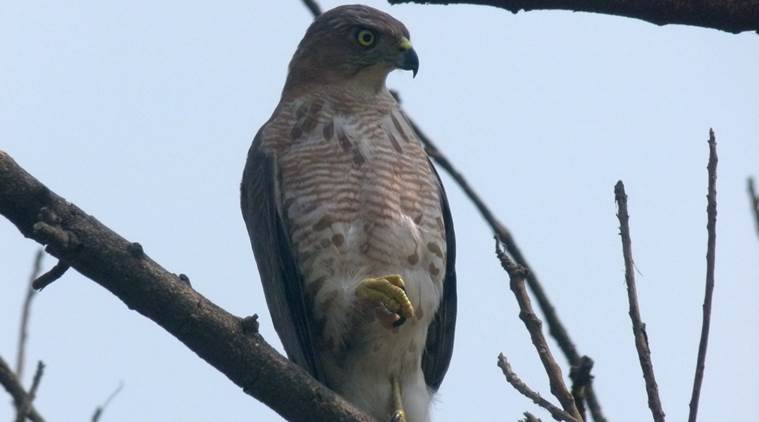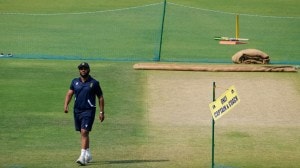Down in Jungleland: Park Trails
Don’t whine if you spot no big cats, there’ll always be something to see on a nature ramble.
 Hawk-eyed: Shikras are no pushovers, keep your eyes and ears open.
Hawk-eyed: Shikras are no pushovers, keep your eyes and ears open.
Visitors to tiger reserves, national parks and sanctuaries often grumble, after a three-hour drive through the forest, that they “saw nothing”. Some even loudly demand refunds if the tiger didn’t make an appearance or performed a cabaret in front of their Gypsy. Well, how much can you see while on a nature ramble, really? Of course, it goes without saying that you need to keep your eyes open and mouths shut through the entire duration.
I checked this out for myself on a recent ramble with friends at the Yamuna Biodiversity Park in Delhi. First, I was visiting the park after an unconscionable gap and had a grown-ups-meeting-irritated- children-after-ages moment and said to myself, looking at the foliage: “My, my, how you’ve grown! You were this tiny when I saw you last.” The pathways winding through the place resembled authentic jungle trails.
We were brought to a halt five minutes into the walk by the ubiquitous Plain Tiger butterfly, sunning itself, its orange wings glowing fiery against the emerald foliage. Near the “deep water body” a pair of lime butterflies, in black and yellow splotched with crayon smudges of mauve and orange, were either flirting with or driving each other away. Its pupae adopt a nifty disguise strategy: formed during the monsoon months, they are green like their surroundings, but those formed after monsoon are dry-twig brown in order to merge with the now-drying foliage. It’s astonishing to think how this might work: an internal genetic-switch with a built-in timer that clocks daylight hours or checks on the humidity, perhaps. Wow!
The quiet, deep waterbody, which had overflowed its banks and inundated the path running alongside, was awaiting the arrival of migratory waterfowl. Three cheerful locals — whistling-teals — went out for a swim. A grey heron, moody as a fisherman, sat hunched accompanied by a silent red-wattled lapwing and a busy Indian moor-hen. The islands in the lake had a handful of cormorants. There was an air of expectancy hanging over the placid waters, just the curtain had to go up for the winter show.
Enormous black kites wheeled and mewled everywhere and then began our hide-and-seek game with a shikra. Perched on a bough, looking for all the world like a stump, it kept looking down at its feet — it had drawn one leg up, with the claws clenched as if it were holding something. As I sneaked in closer, it dived off and landed on a tree where the light was better. Those vice-like talons were closed like your fingers would be over a gold sovereign you were concealing from the tax people! Alas, photographs revealed it was empty-handed! Again, the bird flew off to yet another perch, and then vanished. But the shikra wasn’t done yet. Suddenly, it dived out of nowhere and zoomed close past my head, making me feint — reminding me of a similar incident many moons ago on the Northern Ridge in Delhi. These guys are no pushovers!
We clambered on to the creaking bamboo bridge, disturbing a pair of grey herons standing along the banks of the “shallow water body”. In the distance, a pair of cormorants swum and dived, but neither spread its wings out to dry. From the rustling foliage came the xylophone-like call of the yellow-bellied warbler — but the bird (which I’ve nearly always met here) remained unseen. And just beyond this bridge is a favourite haunt of munias as a pair of squeaking silverbills (white-throated munias) put on a show, as they checked out the high grass for seeds.
But this is really the prime season for insects. Dragonflies, tawny as the dried grass, saffron orange, and brown as the soil, zithered around, resting all too briefly: a grasshopper, also brown, ratcheted up its massive hind legs preparing for yet another leap of faith (perhaps, its thigh muscles work like a stretched rubber-band).
A koel, black and satiny, sat concealed in thick foliage, and then, at the edge of a small lily pond, was yet another shikra. This one also standing on one leg, fluffed up like the Michelin man, stock-still. Then the idiot koel shrieked in its usual lunatic manner and flew away. The shikra was gone too. Had it been standing there patiently waiting for a frog? Would it come back here once it thought the coast was clear again? Why had it been standing on one leg? Why had it fluffed itself up so? (Winter was still a couple of months away). We moved on as the answers elude us.
With nature, alas, there’s always so much more to see, experience and question than you have the time for. So, to complain that you haven’t seen or heard anything while on a nature ramble can only mean you kept all your senses in shutdown mode: Which is actually exactly what you need to do to your mobile phone.





- 01
- 02
- 03
- 04
- 05


























